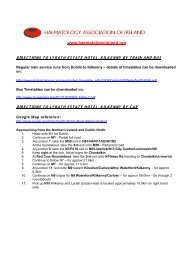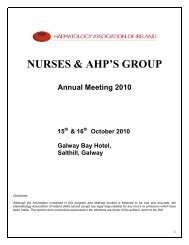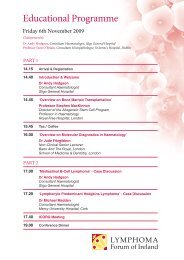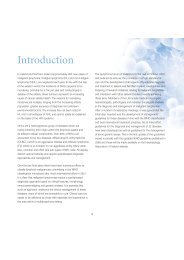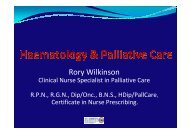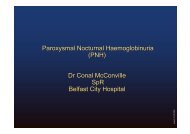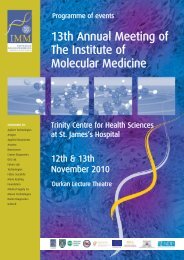Guidelines on Diagnosis and Treatment of Malignant Lymphomas
Guidelines on Diagnosis and Treatment of Malignant Lymphomas
Guidelines on Diagnosis and Treatment of Malignant Lymphomas
You also want an ePaper? Increase the reach of your titles
YUMPU automatically turns print PDFs into web optimized ePapers that Google loves.
Introducti<strong>on</strong><br />
In Irel<strong>and</strong> <strong>and</strong> Northern Irel<strong>and</strong> approximately 800 new cases <strong>of</strong><br />
malignant lymphoma, Hodgkin lymphoma (HL) <strong>and</strong> n<strong>on</strong>-Hodgkin<br />
lymphoma (NHL), are registered each year. In line with the rest<br />
<strong>of</strong> the western world, the incidence <strong>of</strong> NHLs appears to be<br />
increasing, probably by 3-5% per year <strong>and</strong>, being largely a<br />
disease <strong>of</strong> the elderly, these tumours represent an increasing<br />
cause <strong>of</strong> cancer-related death. The reas<strong>on</strong>s for increasing<br />
incidence are multiple, ranging from the increasing elderly<br />
populati<strong>on</strong>, greater accuracy <strong>of</strong> diagnosis <strong>and</strong> unknown<br />
envir<strong>on</strong>mental factors. The increase has not been noted in<br />
HL <strong>and</strong> in all subtypes <strong>of</strong> NHL <strong>and</strong> cannot solely be explained<br />
<strong>on</strong> the basis <strong>of</strong> the HIV epidemic.<br />
NHLs are a heterogeneous group <strong>of</strong> diseases which are<br />
mainly linked by their origin within the lymphoid system <strong>and</strong><br />
its different cellular comp<strong>on</strong>ents. Over 60% <strong>of</strong> NHLs are<br />
accounted for by two diseases, diffuse large B-cell lymphoma<br />
(DLBCL) which is an aggressive disease <strong>and</strong> follicular lymphoma<br />
(FL) which is an indolent or n<strong>on</strong>-aggressive entity. Many other<br />
less- comm<strong>on</strong> <strong>and</strong> <strong>of</strong>ten rare sub-types <strong>of</strong> NHL exist. All display<br />
distinct natural histories <strong>and</strong> require complex diagnostic<br />
approaches <strong>and</strong> management.<br />
The Lymphoma Forum <strong>of</strong> Irel<strong>and</strong> (LFI) first met in October 2002<br />
<strong>and</strong> outlined its aims as: the promoti<strong>on</strong> <strong>of</strong> a high st<strong>and</strong>ard <strong>of</strong><br />
care <strong>and</strong> the development <strong>of</strong> all aspects <strong>of</strong> lymphoma diagnosis<br />
<strong>and</strong> treatment in Irel<strong>and</strong> <strong>and</strong> Northern Irel<strong>and</strong>, development <strong>and</strong><br />
fostering <strong>of</strong> research initiatives relating to malignant lymphomas<br />
<strong>and</strong> interacti<strong>on</strong> with other relevant bodies towards achieving<br />
these aims. Members <strong>of</strong> the LFI include medical <strong>on</strong>cologists,<br />
haematologists, pathologists <strong>and</strong> radiati<strong>on</strong> <strong>on</strong>cologists involved<br />
in the diagnosis <strong>and</strong> management <strong>of</strong> malignant lymphomas.<br />
After a number <strong>of</strong> exploratory meetings, it was agreed that the<br />
initial step required was the development <strong>of</strong> management<br />
guidelines for these diseases in line with the WHO classificati<strong>on</strong><br />
<strong>and</strong> best internati<strong>on</strong>al treatment practices. As an initial effort,<br />
guidelines for the diagnosis <strong>and</strong> management <strong>of</strong> 22 diseases<br />
have been developed as well as guidelines for the management<br />
<strong>of</strong> some generic issues. This is the first update <strong>of</strong> the guidelines<br />
issued in parallel with the updated WHO guidelines published in<br />
2008 <strong>and</strong> these will be made available <strong>on</strong> the Haematology<br />
Associati<strong>on</strong> <strong>of</strong> Irel<strong>and</strong> website.<br />
Over the last forty years there have been numerous efforts to<br />
classify lymphoid malignancies culminating in the WHO<br />
classificati<strong>on</strong> introduced after much internati<strong>on</strong>al effort in 2001.<br />
It is clear that malignant lymphomas require a sophisticated<br />
diagnostic approach based <strong>on</strong> clinical features, morphology,<br />
immunophenotyping <strong>and</strong> genetic analysis. It is essential that<br />
such an approach underpins the clinical management <strong>of</strong> these<br />
diseases, many <strong>of</strong> which are amenable to cure. Clinical care<br />
should be delivered by those with expertise <strong>and</strong> experience<br />
in the area, within a multidisciplinary setting.<br />
1




